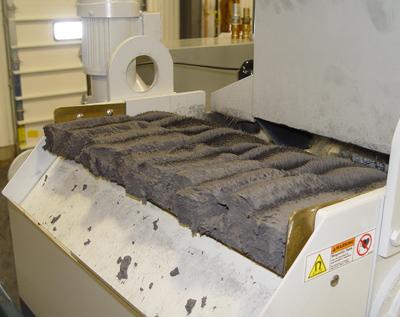
Flow Pro Products' high strength rare earth magnetic filters deliver high performance filtration levels for minimally ferrous materials such as high speed steels, tool steels and carbides, and final metalworking processes for close tolerance component manufacturing. These filters are capable of maintaining machine tool coolants to 10µm nominal clarity, without the need for consumable filtration media.
Processes like super-finishing, honing, micro-sizing, lapping and burnishing generate extremely small particulate and make filtration operations very challenging, expensive, and maintenance intensive. The system is capable of removing all solid particulate (magnetic and non-magnetic) down to a nominal clarity of 10µm, yielding an average particle loading of 50 PPM or less. These Rare Earth Magnetic Filtration Systems eliminate the operational expenses of purchased filter media and filter-aid powders. They also eliminate the maintenance intensive chores involved in operating complicated filtration processes.
What distinguishes Flow Pro Products' line of Rare Earth Magnetic Filters is the extended pole design, high power Neodymium Iron Boron drum construction, and the logic employed to index the drum, automatically on demand. Compared to smooth cylindrical drums that rotate continuously, the raised pole design employs 40 percent more magnetic surface area per linear foot. The drum is designed to index on demand and does not rotate continuously, so the captured contaminants that are discharged are drier, and that in turn reduces coolant loss.
The automatic indexing control logic will only rotate the drum when the fluidic probe generates a signal, which occurs as the captured contaminants continue to build up in the intense magnetic field. The purpose behind this circuitry is to maintain the optimal porosity of the filter matrix which is dictated by the application, flow rate, and the sizing selection. This results in the most reliable and efficient filtration and removal of magnetic and non-magnetic contaminants from metal working coolants. These units can achieve 10µm nominal coolant clarity and the removal of 99 percent of all grinding fines over 10µm.
Contact Details
Related Glossary Terms
- burnishing
burnishing
Finishing method by means of compressing or cold-working the workpiece surface with carbide rollers called burnishing rolls or burnishers.
- coolant
coolant
Fluid that reduces temperature buildup at the tool/workpiece interface during machining. Normally takes the form of a liquid such as soluble or chemical mixtures (semisynthetic, synthetic) but can be pressurized air or other gas. Because of water’s ability to absorb great quantities of heat, it is widely used as a coolant and vehicle for various cutting compounds, with the water-to-compound ratio varying with the machining task. See cutting fluid; semisynthetic cutting fluid; soluble-oil cutting fluid; synthetic cutting fluid.
- grinding
grinding
Machining operation in which material is removed from the workpiece by a powered abrasive wheel, stone, belt, paste, sheet, compound, slurry, etc. Takes various forms: surface grinding (creates flat and/or squared surfaces); cylindrical grinding (for external cylindrical and tapered shapes, fillets, undercuts, etc.); centerless grinding; chamfering; thread and form grinding; tool and cutter grinding; offhand grinding; lapping and polishing (grinding with extremely fine grits to create ultrasmooth surfaces); honing; and disc grinding.
- lapping
lapping
Finishing operation in which a loose, fine-grain abrasive in a liquid medium abrades material. Extremely accurate process that corrects minor shape imperfections, refines surface finishes and produces a close fit between mating surfaces.
- metalworking
metalworking
Any manufacturing process in which metal is processed or machined such that the workpiece is given a new shape. Broadly defined, the term includes processes such as design and layout, heat-treating, material handling and inspection.
- tolerance
tolerance
Minimum and maximum amount a workpiece dimension is allowed to vary from a set standard and still be acceptable.
- tool steels
tool steels
Group of alloy steels which, after proper heat treatment, provide the combination of properties required for cutting tool and die applications. The American Iron and Steel Institute divides tool steels into six major categories: water hardening, shock resisting, cold work, hot work, special purpose and high speed.
